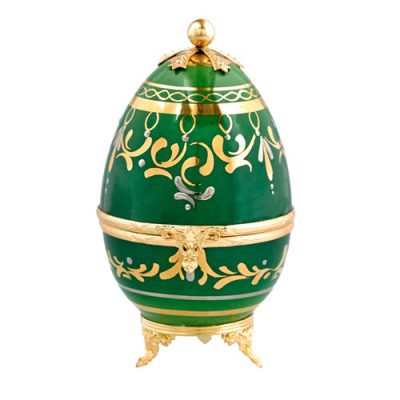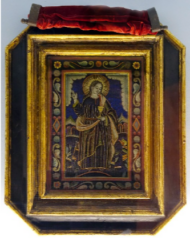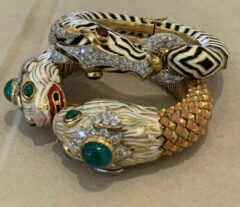
Limoges…what is it? Those porcelain dinnerware sets, trinkets boxes, and tea sets adorned with fluffy, pink, cabbage-style roses, tend to be categorized as examples of the “Limoges” porcelain. Limoges, however, is not a company, but rather a term which has come to encompass a variety of porcelain pieces produced in a specific area.
Limoges refers to a region in the middle (slightly to the west) section of France. In the 1770s, it was discovered that areas rich with suitable clay were located near Limoges, and so, several porcelain factories set up shop in this region. Therefore, “Limoges” doesn’t denote a particular company, but rather the area where the factory was located: Limoges. Debby Dubay, a Limoges porcelain expert, explains that because there were so many factories working in this area (over 48) and a myriad of identifying marks (over 400), the term “Limoges has ultimately become the generic name for all of the porcelain produced in factories in this region” (Dubay 9). (Tressemann & Vogt (T&V), Bernardaud, William Guerin (W.G.& Co.), Jean Pouyat (J.P.L), and Haviland & Co. are some of the more widely known of the Limoges-based factories today).
Because of its beauty and quality of porcelain, Limoges pieces are still highly collected and sought after, with the factory-decorated “Limoges” being the most desired and valuable. These pieces were hand-painted by French factory artists (rather than the design applied as a decal-transfer—like a sticker). There should be two marks on such a piece: the factory mark and the decorating mark. Here are some terms to be familiar with:
- Blank: the shape of the undecorated porcelain. The blanks would then be decorated by factory’s decorating studio, or they could be sold or outsourced to another factory/artist studio specializing in decoration.
- Underglaze factory mark(sometimes called the backstamp or whiteware-mark): this mark was imprinted onto the undecorated, unfired, “unglazed” porcelain blank. It can be a logo, a set of letters, a name, or a symbol and it will usually be green or black. This mark identifies the specific factory in Limoges which produced that piece of porcelain. (There were over 48 porcelain factories in the Limoges area, remember!) This mark should, except in very rare instances, be present.
- Overglaze decorating mark: from the factory, decorating studio, or the artist which decorated the blank. Since this mark is on top of the glaze, it will look clearer than the underglaze factory mark. The decorating mark is usually a red, blue, or purple color.
- Import mark: sometimes a third mark will appear on the piece. If that piece was ordered by an overseas retailer, this mark would identify the store it would have been sold at (i.e. Tiffany’s, New York).
(I recommend studying Dubay’s book, which includes over twenty pages featuring hundreds of examples of these marks.)
Lessons in Limoges
Limoges are a particular victim of reproductions and fakes. There are many giveaways, though, that the savvy collector can be armed with, specifically helping with the marks, material, and “maturity.” With advice from Dubay’s book, here is an appraising checklist:
Meddling with the “Marks”
- True Limoges come from France! If the mark includes “CHINA” or “ROC” (Republic of China)—beware!
- If the mark features a gold script or fleur-de-lis, this is rings of inauthenticity.
- Whereas a true Limoges could have up to three marks, a fake/reproduction would, at the most, have just one.
- A fake/reproduction’s “underglaze factory” mark differ from the traditional color scheme of true Limoges marks: fakes are usually light blue, gray, or gold, rather than the familiar green or black.
Material Magic
- The tap-test: Limoges pieces are made from a hard-paste porcelain** (refer to history section below). When tapped with a finger, this type of porcelain will have a pure, clear-as-crystal ring. (A fake/reproduction will emit a “thud” sound).
- Go for the glow! Limoges porcelain has a translucency when held up to light, whereas fake/reproductions will be opaque.
- Hand-painted Limoges have more intricate designs painted in muted colors. (Fakes/reproductions would appear simpler and use bolder colors).
Maturity is key: Limoges porcelain ages well!
- A true Limoges is an antique. Therefore, its gold paint should have accrued a patina over the years. According to Dubay, a reproduction would feature “offensively bright gold in perfect condition” (Dubay 23).
- Hard-paste porcelain is a durable material. Therefore, a true Limoges wouldn’t suffer from cracking, crackling, or crazing. A true Limoges looks pretty much brand-new!
- If you want to collect an authentic Limoges, then the condition is extremely important. According to art appraisers, a marked piece in perfect condition is the safest buy.
A brief history of hard-paste porcelain
**Hard-paste porcelain: Hard-paste porcelain can be thought of as more “durable” than soft-paste porcelain, as hard-paste is fired at a higher temperature and is less likely to crack.
Hard-paste porcelain was first developed in China in the 8th century. Soon after hard-paste porcelain products were imported to Europe during the Middle Ages, European manufacturers began to develop their own hard-paste porcelains as well. Previously, European manufacturers had been using soft-paste porcelain.
Meissen porcelain, the famous German porcelain/china company, was the first European manufacturer to develop and use hard-paste porcelain, beginning in 1708. Meissen porcelain was considered the preeminent fine art porcelain of Europe, later surpassed by Sèvres porcelain. The French Sèvres porcelain factory became the standard setter of porcelain for its artistry and quality, and it still retains this prestige to this day. One spectacular example of the Sèvres magnificence is its Vase potpourri à vaisseau (the “potpourri vase vessel”). The vase vessel mimics the shape of a colossal wooden captain’s ship (you know, those massive ships decorated with baroque carvings which were painted in red, yellow, blue, green, and gold!). With the Sèvres version, beautiful gold paint outlines the billowing sail, complete with a streaming flag curling itself around the mast. Even the potpourri scent holes are a great feature— they become the tiny portholes on the Sèvres ship! This was one of Sèvres’ most famous pieces (coveted by King Louis XV’s mistress Madame de Pompadour). It was also one of the rarest; today, there are only ten known examples, and these mostly reside in museums.
Dubay, Debby. Antique Trader Limoges Price Guide. Krause Publications, 2007.
Michelle Miller






